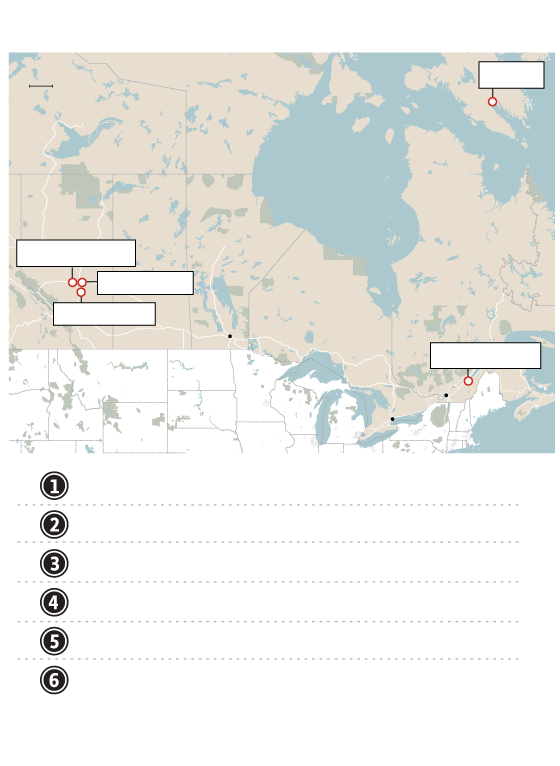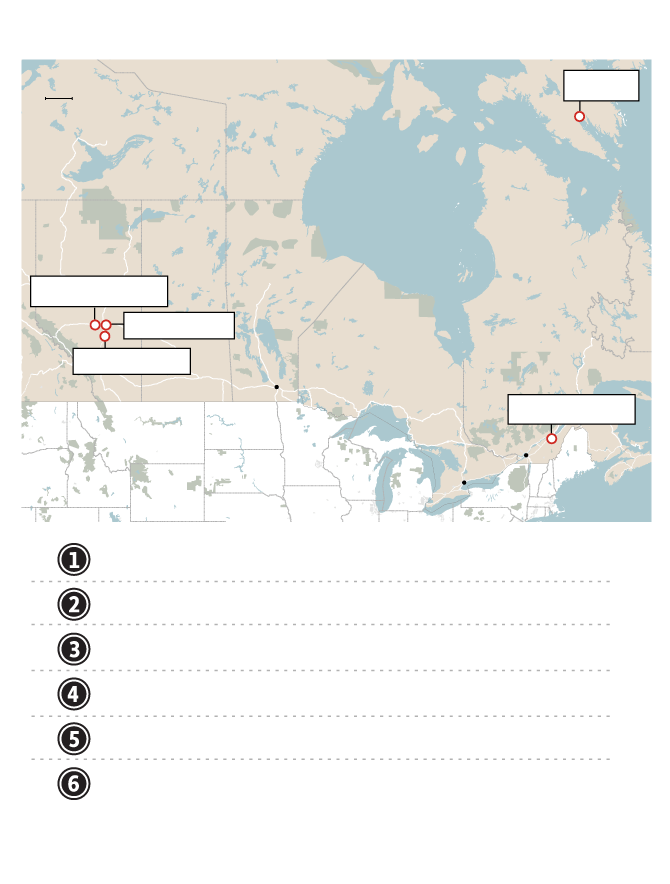Pope Francis blesses the crowd with holy water after performing the pilgrimage to Lac St Anne, Alberta on July 26, 2022.Gavin John/The Globe and Mail
Pope Francis sat in his wheelchair under a wooden pavilion topped with a white cross, his back to thousands of pilgrims gathered at Lac Ste. Anne. He faced north, toward the water, and said a prayer in the Tuesday afternoon sun.
In English broadcast over loudspeakers, he thanked the Lord for the gifts of creation – especially water, a source of life, refreshment and cleanliness. He blessed the lake’s shallow waters, which Indigenous people have long considered sacred. It was first known as Wakamne, or God’s Lake, by the Alexis Nakota Sioux Nation, and as Manito Sahkahigan, or Spirit Lake, by the Cree.
The Pope was then wheeled out of the pavilion and down to the water’s murky edge. He once again sat with his back to the throngs of pilgrims quieted by his presence. Dozens of boaters looked back at him and the assembled crowd. Pope Francis, who arrived in Canada on Sunday for what he calls a penitential pilgrimage, sat alone with his head bowed.
Pope Francis calls on faithful to be ‘weavers of hope’ at stadium mass in Edmonton
Then, facing the crowd, he sprinkled blessed water on the fresh concrete near the lakeshore. Reserved cheers and gentle drum taps broke the silence and Pope Francis became the first participant in this year’s Lac Ste. Anne pilgrimage. Catholics have been flocking here since 1889 and tens of thousands of believers are expected to wade into Lac Ste. Anne over the coming days. Pilgrims believe these waters have healings powers, capable of miracles. (Alberta Health Services issued an advisory on July 21 for blue-green algae bloom on Lac Ste. Anne; the Pope did not enter the water.)
Tony Alexis, chief of the First Nation that bears his surname; George Arcand Jr., Grand Chief of the Confederacy of Treaty Six First Nations; and Audrey Poitras, president of Metis Nation of Alberta, accompanied the Pope as he moved south toward Lac Ste. Anne’s shrine for vespers, or evening prayers.
“Âba-wash-did! Tansi! Oki!,” Pope Francis said in Nakota, Cree and Blackfoot at the start of his homily. The crowd broke into cheers after the Pope uttered words in languages the Canadian government and Catholic Church tried to eliminate.
Pope Francis’s pilgrimage to Lac Ste. Anne marked his last public appearance in Alberta before he flies to Quebec Wednesday morning. On Monday, he went to Maskwacis, in central Alberta, to apologize to Indigenous people for the role Christians played in residential schools, and later joined parishioners at Edmonton’s Sacred Heart Catholic Church of the First Peoples. On Tuesday, he led a public mass in the city’s Commonwealth Stadium before going to Lac Ste. Anne, a Métis and First Nations community about 85 kilometres northwest of Edmonton.
At the shrine, the Pope wore a Métis sash as a stole while addressing the crowd in Spanish, with a member of his entourage translating the homily into English.
Pope Francis spoke of honouring grandparents, the importance of family history and a future where violence and marginalization of Indigenous people is never repeated during an outdoor mass in Edmonton on Tuesday.
The Globe and Mail
“I am very pleased to be here, a pilgrim with you and among you. In these days, and today in particular, I have been struck by the sound of drums that accompanied me wherever I went,” the Pope said, again eliciting cheers. “This beating of drums seems to echo the beating of so many hearts – hearts that, over the centuries, have beat near these very waters; hearts of the many pilgrims who walked together to reach this lake of God.”
Alexis oral history holds that a Nakota chief from the southeast followed a vision and led his people to the shores of this lake. In 1844, Rev. Jean-Baptiste Thibault established the first permanent Catholic mission west of Winnipeg here, blessing it Lac Ste. Anne. The Oblates of Mary Immaculate organized the first pilgrimage, which has continued each year during the week of July 26 for the feast of St. Anne, who was Jesus’s grandmother.
“I am struck by the vital role of women in Indigenous communities. They occupy a prominent place as blessed sources not only of physical but also of spiritual life,” the Pope said in another section of the homily that received applause. “In thinking of your kokum, I also remember my own grandmother. From her, I first received the message of faith and learned that the gospel is communicated through loving care and the wisdom of life.
“Faith rarely comes from reading a book alone in a corner. Instead, it spreads within families, transmitted in the language of mothers, in the sweetly lyrical accents of grandmothers,” he said.
A large, curious object was stationed to the immediate left of the stage in the shrine. The object was partly covered with a shroud, though the bottom half was visible behind bouquets of red roses. It was a sculpture called Mary, Untier of Knots, and Pope Francis blessed it in the presence of its proud creator, sculptor Timothy Schmalz of St. Jacobs, Ont., and an audience of about 2,000 people.
The life-sized sculpture was inspired by, and is faithful to, the baroque painting of the same name by Johann Georg Melchior Schmidtner, which hangs in a church in Augsburg, southern Germany. It depicts Mary standing on a crescent moon, surrounded by angels as she unties knots from a long ribbon.
In an interview just before the Pope’s arrival at the shrine, Mr. Schmalz, 52, said that the Catholic residential schools can be interpreted as one of the knots and that the statue itself can represent Pope Francis.
“Francis is coming face-to-face with the historical injustices and sins of the past, like the residential schools,” he said. “I consider this statue an emotional portrait of Francis, who is trying to untie the knots here – the injustices suffered by the Indigenous peoples.”
Mr. Schmalz is well known to Pope Francis and to one of his high-ranking cardinals, Michael Czerny, who accompanied the Holy Father on his apology-and-reconciliation tour of Canada this week.
In 2016, Pope Francis allowed Cardinal Czerny, who is Canadian, to commission a monumental bronze sculpture by the artist on the theme of refugees. The result was a six-metre-long bronze of 140 figures standing in a boat. Each of them depicts a refugee or migrant, from Jews fleeing Nazi Germany to Syrians escaping the Syrian civil war; two of them depict Cardinal Czerny’s parents. It was placed in Vatican City’s St. Peter’s Square in September, 2019 – the first sculpture addition there in four centuries.
Mary, Untier of Knots was cast in clay last year at Mr. Schmalz’s studio. An identical version made of light resin was recently delivered to Lac Ste. Anne. Mr. Schmalz and his sponsors are giving the statue to Pope Francis, who in turn is giving it to the shrine at Lac Ste. Anne.
Eventually, the resin version will be cast in bronze.
During the Lac Ste. Anne pilgrimage of 1991, Doug Crosby, then the head of the Oblate Conference of Canada, apologized to Indigenous people for the role the missionaries played in establishing and running residential schools. He acknowledged sexual and physical abuse occurred at the institutions, noting the largest problem was the existence of the residential school system itself.

Jane Weyallon Armstrong, a MLA in the Northwest Territories who journeyed to see Pope Francis.Jana Pruden/The Globe and Mail
Jane Weyallon Armstrong, an MLA in the Northwest Territories who journeyed to Alberta to see the head of the Roman Catholic Church, said her feelings about the Pope’s visit to Lac Ste. Anne were bittersweet.
“Not sad, but a little bit emotional thinking about my late parents, thinking about my brother. Thinking about my ancestors,” she said, wearing a rosary around her neck and with a crisp new “I Love Pope Francis” T-shirt.
A country version of Amazing Grace echoed across the fields as she spoke. She said she was happy, and loved her faith and her church.
“It’s time to make peace,” she said. “I don’t want to be angry any more.”
Myles Wood has attended the pilgrimage at Lac Ste. Anne twice before, and was going to skip this year until he learned that the Pope would be attending.
He said he immediately knew he would make the trip from his home in St. Theresa Point in northern Manitoba, and began saving money for the lengthy and expensive journey from the fly-in community.
“He’s the Pope!” he said. “I’ve never had the chance to do this, meet him like that. Especially this close.”
He, his wife and mother set up their chairs in the sun across from the lake early, waiting hours in the sun for the Holy Father to arrive.
“I’m happy,” he said. “And sometimes sad. But mostly, happy.”
Pope Francis apologized Monday for the Catholic Church’s role in the abuse at residential schools in Canada. Speaking through a translator, the Pope said that while there were “many instances of devotion and care for children,” the overall effects of residential school policies were “catastrophic.”
The Globe and Mail
Ariane Starblanket and her father, Garry Tuckanow, travelled with seven family members from their homes in the Star Blanket and Okanese Nations in Saskatchewan, making the pilgrimage for the first of what will be four trips here in the years to come.
Ms. Starblanket said they were feeling a bit uneasy and unsure about attending at first, but that her father decided that he needed to come, and that they should make the trip as a family.
“He wanted to be by the water,” Ms. Starblanket said. “He wanted to be at the lake, and also for us to really acknowledge what the Pope had said about universal reconciliation.”
Moments after seeing the Pope at the shoreline, Mr. Tuckanow described the power of the experience.
“Beautiful,” he said. “Unreal. Surreal. Joyful.”
“We cried and we prayed,” Ms. Starblanket said. “But now we’re leaving it here.”
“No more sorrows,” her father added.

Where the Pope will be on visit to Canada
Iqaluit
0
150
KM
NWT
NUN.
Hudson
Bay
ALTA.
MAN.
SASK.
Lac Ste. Anne
NFLD.
Edmonton
QUE.
Maskwacis
ONT.
Winnipeg
Quebec City
UNITED STATES
Montreal
Toronto
Sun., July 24: Depart Rome; arrive Edmonton
Mon., July 25: Edmonton; Maskwacis
Tues., July 26: Edmonton; Lac Ste. Anne
Wed., July 27: Depart Edmonton; arrive Quebec City
Thurs., July 28: Quebec City
Fri., July 29: Depart Quebec City; arrive Iqaluit; Rome
THE GLOBE AND MAIL, SOURCE: TILEZEN; OPENSTREETMAP
CONTRIBUTORS; Bulletin of the Holy See Press Office

Where the Pope will be on visit to Canada
Iqaluit
0
150
KM
NWT
NUN.
Hudson
Bay
ALTA.
MAN.
SASK.
Lac Ste. Anne
NFLD.
Edmonton
QUE.
Maskwacis
ONT.
Winnipeg
Quebec City
UNITED STATES
Montreal
Toronto
Sun., July 24: Depart Rome; arrive Edmonton
Mon., July 25: Edmonton; Maskwacis
Tues., July 26: Edmonton; Lac Ste. Anne
Wed., July 27: Depart Edmonton; arrive Quebec City
Thurs., July 28: Quebec City
Fri., July 29: Depart Quebec City; arrive Iqaluit; Rome
THE GLOBE AND MAIL, SOURCE: TILEZEN; OPENSTREETMAP
CONTRIBUTORS; Bulletin of the Holy See Press Office

Where the Pope will be on visit to Canada
Sun., July 24: Depart Rome; arrive Edmonton
Iqaluit
Mon., July 25: Edmonton; Maskwacis
Tues., July 26: Edmonton; Lac Ste. Anne
Wed., July 27: Depart Edmonton; arrive Quebec City
Thurs., July 28: Quebec City
Fri., July 29: Depart Quebec City; arrive Iqaluit; Rome
Hudson
Bay
ALTA.
SASK.
MAN.
Lac Ste. Anne
NFLD.
Edmonton
QUE.
Maskwacis
ONT.
Winnipeg
CANADA
UNITED STATES
Quebec City
PEI
N.B.
Ottawa
Montreal
N.S.
Toronto
0
150
KM
THE GLOBE AND MAIL, SOURCE: TILEZEN; OPENSTREETMAP CONTRIBUTORS; Bulletin of the Holy See
Press Office
Our Morning Update and Evening Update newsletters are written by Globe editors, giving you a concise summary of the day’s most important headlines. Sign up today.